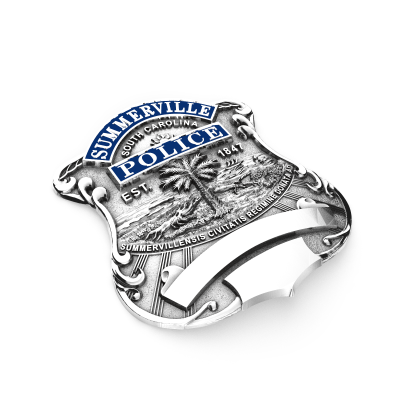What's the difference between One-Piece and Applied Panel badges?
In this article, we will discuss the differences between these two different badge types.
What's the difference between One-Piece and Applied Panel badges?
We are often asked by police and fire departments, "What is the difference between One-Piece and Applied Panel badges?" Although these two badge types may appear similar from a distance, the most notable difference is in their construction. One-piece badges are made out of one piece of metal, whereas Applied Panels, also known as layered badges, are made up of multiple pieces soldered together.
In this article, we will discuss the unique features of each badge style, examine their costs and manufacturing time, and offer guidance on choosing the most suitable badge for your department.
One-Piece Badge Features:
One-piece badges are constructed from a single piece of metal.
Key features of one-piece badges include:
- Lighter in Weight: As they require less metal to make, one-piece badges are generally lighter.
- Ideal for Badge Wallets: Their reduced metal volume allows one-piece badges to fit better in badge wallets, offering enhanced convenience and comfort.
- Detailed Design: Advancements in steel die technology enable intricate sculpted detailing on one-piece badges, resulting in visually appealing designs.

Applied Panel Badge Features:
Applied Panel badges, also known as layered badges, are composed of multiple pieces soldered together.
Notable features of these badges are:
- Wide range of unique styles - Constructed with a badge base and panels, applied panel badges offer a varied array of arrangements, providing numerous badge options to personalize for your department. Among the most common badge styles for applied panel badges are eagle top shields and ovals.
- More weight and volume - Due to their layered construction, applied panel badges possess more weight and volume, which can be desirable for some individuals.

Does one cost more?
On average, applied panels cost 30-40% more than a one-piece of similar size and design. This is because applied panel badges require more manufacturing steps and labor. You can read our article here to learn more about how much a badge costs.
Does one badge type take longer to manufacture?
Applied panel and one-piece badges both take 4-6 weeks to manufacture. If you are interested in learning about how long a badge takes to make, please read our article here.
Do both badges come with a Lifetime Warranty?
Whether you opt for a one-piece or applied panel badge, both badge types are backed by our Lifetime Warranty. If you want to learn more about our Lifetime Warranty, please click here.
Choosing the right badge for your department:
Now, you might wonder which badge category is best for your police or fire department. It's important to note that neither is inherently better than the other. Each badge type has its own unique characteristics. The decision should be based on personal preference and specific needs. It is advisable to focus on the badge's style, layout, and lettering fit rather than solely on its construction.
Personalization and designing:
Our online design tool, Visualbadge, lets you easily personalize one-piece and applied panel badges. Please refer to our related article on designing a custom badge.
If you require assistance determining the best badge for your organization, please don't hesitate to contact us. Our dedicated team is here to guide you.
Recommended articles in our Learning Center
How long does it take to make a custom badge?
How do I create a custom center seal for my badge?



